Yesterday the DSN crew first saw the video above. What is this large floating sheet of goo? Is it alive? Was it once alive?
The two leading contenders seems to be that it is A) an old whale placenta or B) a rare and enigmatic deep-sea jellyfish. And the answer is…. B)
A) So why is not an old whale placenta? The video is from approximately 5000 feet (1500 m). A placenta would need to sink to this depth without any other organism consuming it. Unlikely given that its rate of decent would have been slow and any organic food source in the deep sea is unlikely to last long.
B) So why is it a jellyfish?* In 1967, F.S. Russell described a very enigmatic deep-sea jellyfish, Deepstaria enigmatica.
During Dive 159 of the U.S. research submersible Deepstar 400 on 22 October 1966 Dr. Eric G. Barham, Dr. George Pickwell, and Mr. Ronald Church collected a remarkable scyphomedusan at a depth of about 723 m in the San Diego Trough…when first noted, the jellyfish’s margin was collapsed and the [outer, convex surface of the umbrella] indented.
In other words it didn’t look like much of a jellyfish. Sound familiar?
On opposite sides of the umbrella are two large tubular shaped processes…It has a yellowish brown tinge…The radial canal system is most striking. It consists of a meshwork, likened by Dr. Barham to wire-netting.
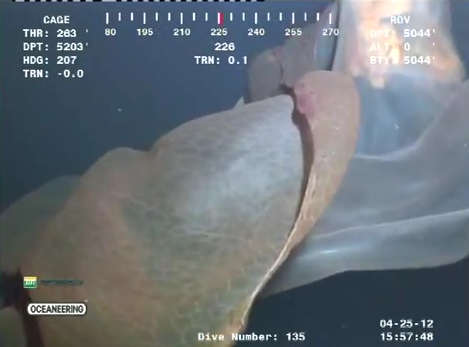
The gonads are situated along the margins of fan-shape mesenteries, and tend to be broken up into several isolated processes with incurved edges.
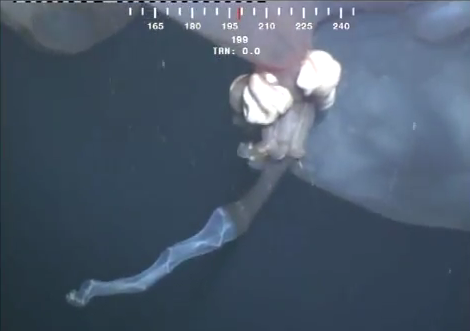
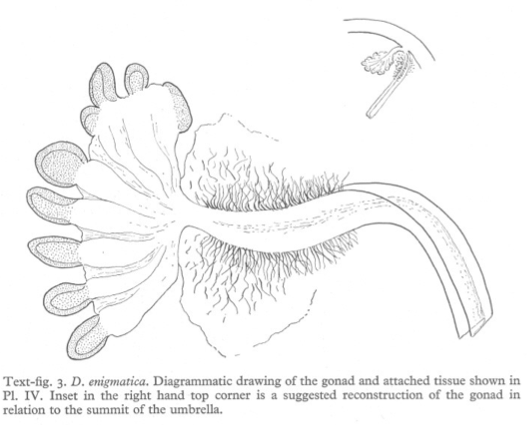
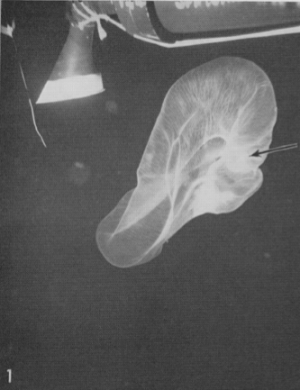
In 1988 Larson and colleagues published further work describing this rare group of jellyfish. They too noted the unique canal system.
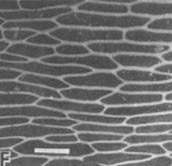
But it is these researcher’s behavioral notes that I find most interesting.
These two species of Deepstaria display some unique behaviour; peristaltic locomotion and pursing of the bell margin are unknown in other medusae. Probably the peristaltic locomotion is necessary because the umbrella is too thin and the subumbrella musculature too diffuse to support more rapid pulsation. Our observations of both species of Deepstaria suggest that they usually hang motionless with the umbrella open…It seems probable to us that medusae in this genus are large ambush predators in the meso- and bathypelagic environment…we speculate that the feeding behaviour might be as follows. The medusae usually hang vertically and motionless with the bell open; occasional peristaltic contractions probably enable them to swim slowly, at least enough to retard sinking. Because the area of the subumbrella is so large, upward-swimming prey occasionally would swim into it. Once prey enter the large subumbrellar chamber, the contact stimulates rapid contraction of the coronal muscle, pursing the umbrella shut and trapping the prey. As the prey attempts to escape, it contacts nematocysts on the subumbrella, being repeatedly stung until weakened. It may additionally become covered with mucus and further immobilized. Then peristalsis and ciliary movement could transport the prey towards the mouth where the oral arms could grasp and engulf it…’Bagging’ prey in this way is not known in other medusae.

Russell, F. S. (1967). “On a remarkable new scyphomedusan Deepstaria enigmatica”. Journal of the Marine Biological Association of the UK 47: 469-473.
Larson, R.; Madin L., Harbison, G. (1988). “In situ observations of deep water medusae of the genus Deepstaria, with a description of D. reticulum sp. nov.”. Journal of the Marine Biological Association of the UK 68: 689-699.
*UPDATE: This has now also been confirmed by Dr. Steven Haddock of the Monterey Bay Aquarium Research Center, an expert on deep-sea and pelagic creatures.
UPDATE2: Steven Haddock provides some much better photos of Deepstaria engimatica on the Jellyfish Watch Facebook page.
UPDATE3: Several comments below suggest the species is Deepstaria reticulum. Important thing is that it is still a jellyfish and already known.





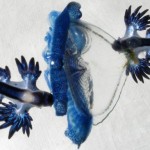

Damn that thing is weird. Any word on how big it was? Actually, forget I asked, it’s already going to be haunting my nightmares tonight.
People have been sending me Digg and IO9 links to this video all day. Thanks for the write-up! Now I can respond.
Thanks for the additional info!
I this YouTube video on Yahoo earlier today and I thought I’d do a bit of research to see if I could find more information about this creature and what it is and I happened upon this site, and boy am I glad I did.
The Yahoo article that I read wasn’t very informative and actually compared this creature to the Loch Ness monster. Basically the kind of sensationalistic fluff that’s common on sites like Yahoo.
Anywho, I just wanted to say thank you for the very informative article. I learned something today and that’s always awesome as well as finding a new site to add to my Google reader.
A very helpful piece of sleuthing! Much obliged, also on behalf of us here at tonmo.
So incredibly mesmerizing. Will watch video again when I can’t fall asleep. Thanks for solving the mystery.
Great article, well-researched, nice citations. I salute you for clean scientific reporting on a most interesting phenomenon.
This one is Deepstaria reticulum, not Deepstaria enigmatica
“Slime”, by Joseph Payne Brennan, which I read in one of those Alfred Hitchcock spooky story books when I was a kid. One of the scarier stories, actually.
This crittur looks almost exactly as I imagined the one in the story.
I second Chuck’s comments.
I wonder if creatures of this type live on gaseous planets like Jupiter, swimming through the thick gasses.
Thanks! This is amazing.
Thanks for the references and excerpts of the papers!
Matt,
thanks so much for your excellent article and for contributing to show this spectacular strange world!
Chris “Chrigel” Karrer
Well, that’s a great analysis and hypothesis. But only by seeing video, we can only predict.the remaining question is are they new or discovered already before?
This remarkably beautiful deep-ocean predator has been photographed in the Pacific and Atlantic. In 2003, James Cameron filmed one in 3-D at the Lost City hydrothermal zone, at a depth of 7/10 mile. (It can be seen in the documentary, “Aliens of the Deep.”)It was one of the few organisms easily identified after filming (which made it no less fascinating). Many other organisms required years even to fit into phyla (as for many of the others, we still don’t know what we were seeing [as in chapter 32, “Farewell, Titanic”). It’s another planet down there, in the ever-black. If given a choice between going up to Earth orbit or back again into the deep – I, for one, would choose the deep, without a millisecond’s hesitation.
P.S. in reply to Chuck: Diameter of organism is approximately 1 meter.
Awesome… Who needs Mars when we have such wondefull creatures on this fine planet of ours… Thanks for this exelent explaination.. and @chuck… i bet this creature wont do you anything harmfull no need for nightmares.. Peace from the netherlands folks
This is such an interesting story! While we know that it has generally been identified as Deepstaria enigmatica, we’ve had a different identification.
Dr. George Matsumoto at the Monteray Bay Aquarium Research Institute, who researches the systematics and ecology of deepsea and open ocean jellies, says “The jelly is Deepstaria reticulum – not Deepstaria enigmatica. It is mostly inside out in the video clip.”
https://www.facebook.com/NIWAInvertebrateCollection
“The Yahoo article that I read wasn’t very informative and actually compared this creature to the Loch Ness monster.”
Yes, Yahoo, because that is anything at all like what the Loch Ness Monster is said to look like. Things like this are why I kind of wish the mainstream news would leave natural history stories alone for a while until they promise to do some fact-checking. O_o
It occurred to me a few minutes in that this video may be as close as you can get to seeing footage of a *really* alien alien.
(And no, I didn’t think of “The Abyss” until about halfway through.)
http://youtu.be/EwCgcwuFsBk check out this new video posted by MBARI – on Deepstaria (featuring images of Deepstaria that are not inside out) and some close relatives.
“Boyfriend” by Justin Bieber is on the suggested videos screen. WHAT THE FRACK?
Thanks for figuring this out. I saw something that may have been similar while blue water diving in the north pacific. It was much closer to the surface (probably around 3m deep). We were all tethered togther on a ‘trapese’ (required safety deal for blue water diving). The thing I saw was probably 10 to 15 meters away and I couldn’t swim over to it and since we collecting diatom mats I was busy and would have gotten a serious talking to if I unclipped, stopped working, and swam off to look at a creepy blobby thing. I was also the only one in our group that noticed it. I just chalked it up to a) a weird egg mass of some sort, b) the world’s most intriguing plastic bag, or c) I have no idea what that thing was.
Of course those are all still posibilities because I didn’t get up very close to it but at least this information gives me a new category d) some kind of freaky scyphomedusan related to this thing.
Thanks again,
Jared
The pipe you see at the beginning of the video is approximately 5 feet in diameter. So this “cascade monster” is much larger than one meter. The video was shot in Gulf of Mexico.
I’m kinda sorry the ‘mystery is solved’; it’s remarkably humbling when we’re faced with yet another unknown occupying the planet along with us.
But this, you can’t take away:
The critter, in the first moments of the video, panicked and left, only to return moments later and begin to ‘study’ the videographer. As critter and vidder became more comfortable in close proximity, critter actually seemed to want to share (“Here’s my left, here’s my right, here’s my under, here’s my alimentary, here’s my gonads. Whachyou got?”)
I don’t care who ya are, how logical or clinical, that was a sweet and selfless act of discovery – on the critter’s part. To overcome fear and offer a friendly, er, hand of first contact? Stunning.
Person on the camera is, in my estimation, one lucky sucker.
What a creepy looking bastard of a jelly! Got the chills watching this. Thank you DSN for bringing some more of the deep into the light.